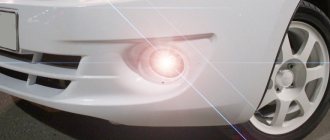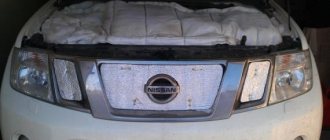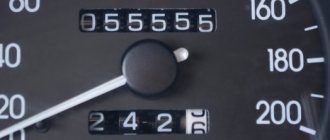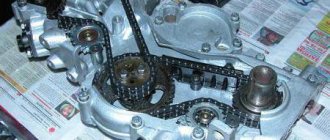Home — Driving Lessons
- Skid
- Braking on slippery roads
- Anti-lock braking system
- Steering when skidding
- Skidding of a front-wheel drive and rear-wheel drive car
- Oversteer
- Skidding during hard acceleration
- Technique for getting a car out of a skid
Unreasonable braking on a slippery road leads to a skid of the car - everyone knows this. But can this problem only happen during hard braking? Do all of you know how skidding occurs and develops, how to deal with it and whether it can be avoided altogether?
I must admit to you in advance that the topic of skidding is difficult to perceive and understand. But this is not the worst thing. Theoretically, it is possible to understand the causes of skidding and methods of combating it. The problem is that when a skid occurs not on paper, but on a real road, many drivers fail to combine theory with practice.
In order to fully assimilate something, you need to “feel” this “something”. Therefore, the recommendation will be as follows. Pick a time, find a suitable location, and practice getting your car out of a skid using the information you've learned in this chapter and other books. If you dare to train, the first “accidental” skid on an ordinary road will not take you by surprise. In the meantime, I advise you to use your imagination more often, then what is written on paper will begin to take on real forms.
Yuz
Each wheel of a moving car has a certain coefficient of adhesion to the road surface. The value of this coefficient depends on many factors (travel speed, road surface material, tire pressure, vehicle load, weather conditions, wheel tire design, and much more). Calculating the coefficient of adhesion for a specific car in a specific situation is difficult and unnecessary. You only need to understand that the car “holds” to the road with a certain effort and that this effort is not unlimited.
Let's look at an example with braking. If it is necessary to reduce the speed, one driver simply removes the gas, another presses the brake pedal a little, and the third “with square eyes” puts so much pressure on the brakes that a little more and his foot along with the pedal will end up in the engine compartment.
In the latter case, the car’s wheels are no longer able to “cling” to the road; they become blocked and begin to slide. The car goes into skidding mode (no skidding yet).
Skidding is the sliding of car wheels on the road surface.
Most often, skidding begins due to excessive force when pressing the brake pedal. However, skidding can also occur when the gas pedal is pressed too hard “to the floor,” as a result of which the car’s wheels turn in place. When cornering at high speed, lateral skidding may occur, which is characterized by a specific “squealing of rubber.”
In other words, if the driver’s unreasonable actions have led to the car’s wheels slipping relative to the road surface, then he has the opportunity to experience the phenomenon of skidding, and later skidding.
How to understand in advance that the car is skidding?
Only experienced drivers can feel that the car is skidding. With long-term driving experience, a person gets used to the dimensions of the car and its various features. Correct landing is also necessary in order to sense in a timely manner that the movement has been disrupted.
Feel that the car has begun to shift, perhaps with your back. For this reason, you should not move too close to the windshield. Do not move away from the back of the driver's seat. The back should be flush with the surface. It’s also not a good idea to drive while reclining, since it will be difficult to respond to a dangerous situation in a timely manner. Hold the steering wheel firmly with both hands.
Skid
A skid is a spontaneous deviation of the trajectory of the wheels (and the entire car as a whole) from the previous direction of movement of the car.
As a rule, a skid is followed by a skid of the car. This is due to the fact that each of the sliding wheels has its own coefficient of adhesion to the road, different from the other wheel.
The difference in the coefficients of adhesion of the wheels to the road leads to the fact that the more “slippery” wheels shift away from the previous trajectory, as a result of which the car begins to turn around its vertical axis (Fig. 55).
Rice. 55. Skid
Which wheels do you think is easier to start sliding - the front or the rear? Which car axle, front or rear, is more susceptible to skidding and skidding?
If you have a couple of free minutes, I recommend going outside and looking at real cars actively braking in front of an intersection. Pay attention to the body of the car, the driver of which “pressed” the brake pedal.
Any car, both rear-wheel drive and front-wheel drive, “nods off” when braking! Its front part is pressed against the road, and the rear part rises up accordingly.
Due to the redistribution of the vehicle’s mass along the axles, the rear wheels “press” on the road less than the front wheels, and their coefficient of adhesion to the road is also less. Therefore, it is easier to lock the rear wheels and make them slide on the road.
The rear wheels of a car are more susceptible to blocking, skidding and skidding than the front wheels.
And it’s good that, first of all, it is the rear wheels that “break” into a skid; such a skid can be successfully combated. The same cannot be said about the front wheels. If the front axle goes into a skid, the car becomes almost uncontrollable!
There is no need to be too scared; skidding of the front axle happens very rarely. And now we’ll deal with the skidding of the rear axle.
Braking on slippery roads
How to stop a car on a slippery road if there is not much space left before the cars standing at a red traffic light?
The first thing to do is remember to use engine braking and forget that you have a left foot. If you do not touch the clutch pedal, the engine will help you brake.
It's more difficult with the right leg. Initially, you need to overcome the desire to press the brake pedal as hard as you can.
Remember, the braking distance on wheels that are blocked and sliding on the road increases by at least 2 times compared to braking on unblocked wheels!
The optimal braking option is a measured force on the brake pedal, ensuring maximum braking efficiency without the wheels blocking and sliding on the road.
However, in extreme conditions, few people manage to control the first press of the brake pedal. Typically, drivers reflexively apply the brakes as hard as possible.
We will assume that you, like many others, failed to “contain your emotions” and the first time you also “squeezed” the brakes. The car's wheels began to spin and it began to skid.
If you continue to hold the brake pedal “to the floor”, the skid will develop, and your car will acquire a stable torque. Therefore, as soon as you felt some “freedom” of your car, saw that the “nose” of your car returned back after the “peck” at the beginning of braking, and that the trunk began to deviate to the side - you must immediately release the brake pedal!
Yes, yes, here they are, the cars are standing, and you need to release the brake pedal! If this is not done, then, rotating around its axis, your car will crash into standing cars!
As soon as you overcome the instinct to “press on the brakes as hard as you can” and tame the irrepressible strength of your right leg, the rear wheels of the car will immediately stop skidding and return to the track of the front ones. The physics of phenomena in a car is such that the rear wheels always want to follow the front wheels and only unreasonable actions of the driver cause them to deviate from the given trajectory.
Therefore, as soon as the wrong action on the part of the driver stops, the skidding of the car that has begun will also stop!
Let's draw an important conclusion:
To stop a skid that has begun, you should take the opposite action to the action that led to the skid!
It could be a little shorter: Action – Skid – Reaction . This rule is suitable for solving problems of incipient skidding during braking, acceleration, and also when skidding on a bend in the road.
Now let's go back to the previous events, because we haven't stopped yet, but there are cars ahead!
You need to release the brake pedal at the beginning of a skid, of course, not forever, but only for a moment, after which you need to “press on the brake” again. Only the second time you need to press the pedal wisely, using less force and trying to feel the edge of the wheels locking.
However, as often happens in practice, the driver fails to find the edge that will ensure braking without locking the wheels a second time. The force on the brake pedal again turned out to be excessively large, the rear wheels began to skid again and the car wanted to skid. But now this shouldn’t scare us, we have a rule that we can use!
Skid?! And why? Did you press the brake pedal? Well, do the opposite - stop pressing the pedal. What? Do you need to stop? So there is a brake pedal - press on! Skid again? Why? And so on.
Depending on the condition of the road surface and the skill of the driver, it is necessary to repeat the “press and release” cycle three, five, ten times, or, better said, as many times as necessary to stop the car in a particular traffic situation.
The above-described method of combating skidding that occurs when braking on a slippery road has its own name: “Intermittent braking.”
If the route of your trip runs along a snowy or even just wet road, then you cannot do without “intermittent braking”. At the same time, you must know and remember that in two specific situations, any braking, including intermittent braking, is unacceptable!
On small slippery sections of the road, you cannot touch the brake pedal at all; only inaction can save you!
Spring, March, drops, streams and large flat puddles. Those of you who get up early in the morning may also remember the second state of these spring puddles. Smooth and durable ice will shine on them for about an hour until 9–10 am.
Unfortunately, in the spring these skating rinks can be found not only on the sidewalk, but also on the roadway. The slightest touch on the brake pedal or any other action by the car's controls instantly leads to an almost uncontrollable skid, and the car approaches the opposite edge of the ice-asphalt sideways. And then what is called overturning or, more simply, “turning over” occurs.
The conclusion is simple:
If you find yourself on a small section of a slippery road, then “without breathing,” without changing anything, drive out of it the same way you entered. In this case, passivity is salvation.
A wet roadside is the second case where lightly pressing the brake pedal can lead to serious consequences.
If, when driving at high or medium speed, a car slides with its right side onto a wet, unimproved shoulder, then a huge difference arises in the coefficient of road adhesion between the right and left wheels. Under these conditions, any braking, even very soft, usually ends with the car overturning.
You can avoid “shifting” in such a situation only if you refrain from active braking and use the steering wheel correctly! And believe me, the work ahead is not easy.
At first, the front right wheel cannot overcome the edge of the asphalt and get out of the mud. In order for the wheel to overcome the edge and get onto the asphalt, you have to turn the steering wheel more and more to the left. And then, at some point, with a sharp jump, the right wheel finally gets out from the side of the road onto the roadway.
But where did the car go? She rushed to the left oncoming side of the road! And this was the second hidden part of the problem.
If you initially know about the impending sharp change in the trajectory of movement, then, of course, you can prepare for active steering, first to the left, and then no less actively to the right. But it’s better not to “jump off while moving” onto the wet side of the road. If going to the side of the road is unavoidable, then at least you should try to reduce your speed before leaving the asphalt.
- Intermittent braking helps prevent the vehicle from skidding and shortens the braking distance.
- On small sections of slippery roads, any actions by the vehicle controls are strictly prohibited.
- If, when driving a car on asphalt, its right wheels slide onto a wet, unimproved shoulder, you should try to return to the asphalt without using active braking.
Rear drive
This is a classic. The driving wheels are at the rear, they push the car forward, and the front wheels turn. That is why, in a turn, as soon as the driver turns the steering wheel to go into a turn and sharply presses the gas, the drive wheels slip and the rear axle tries to overtake the front. skidding occurs
. You need to fight him before the car turns 180 degrees. To do this, turn the steering wheel in the direction of the skid and smoothly remove the traction, that is, release the gas pedal.
To counter a skid on rear-wheel drive, you need to release the gas pedal and turn the steering wheel in the direction of the skid.
To counter a skid on rear-wheel drive, you need to release the gas pedal and turn the steering wheel in the direction of the skid.
And under no circumstances do we press the brakes! This will only make the situation worse.
The main thing here is not to hesitate, to work ahead of the wheel. Otherwise, the car will not stabilize after a skid, but will go into another, then into a third. It's called rhythmic drift
. Each time its amplitude increases, and it becomes more and more difficult to catch the car. Especially, as you might guess, in winter. As a rule, this ends tragically - in a ditch or oncoming traffic.
This is what a rhythmic drift looks like in theory.
And this is how it is in practice.
To reduce the risk of skidding on a winter road, you must adhere to the speed limit, brake before turning and select the gear in which you want to drive this turn ahead of time. If the road is slippery, it is better to choose a lower gear and switch the automatic transmission to manual mode and select, say, third or second gear.
To avoid feeling like a cow on ice, you can use the outside of the turn. There is usually a lot of snow there, and there is ice in the middle and on the inside of the turn. The tires cling to the snow, thus, as athletes say, a “grip” appears. This way you can make the turn safer and faster.
To avoid feeling like a cow on ice, you can use the outside of the turn. There is usually a lot of snow there, and there is ice in the middle and on the inside of the turn. The tires cling to the snow, thus, as athletes say, a “grip” appears. This way you can make the turn safer and faster.
You need to pedal smoothly, but if you need to quickly slow down before turning, apply the brakes vigorously and boldly. ABS system
will prevent the wheels from locking.
The anti-lock braking system does not shorten the braking distance, as is often erroneously claimed, but it allows you to maintain control over the car. This means there is a chance, by turning the steering wheel, to get away from an obstacle or an oncoming car. The Brake Assist system
, can reduce braking distances . Electronics increases the pressure in the brake system without waiting for the driver to fully press the pedal. This allows you to start braking a little earlier, and with the highest possible intensity.
Many modern cars, regardless of the type of drive, also have an ESP stability control system.
. It prevents the car from skidding or drifting. Of course, the system is useful and will help in a difficult situation, but, alas, it is not a panacea for all ills. If the driver goes too fast when entering a turn, the electronics will first brake the drive wheels and then reduce the fuel supply, making it impossible to get the car out of a skid using gas. The driver turns into a spectator.
Most modern cars have a function to disable the ESP system. Either with a button or through the on-board computer menu. As a rule, it is not the stabilization system itself that is turned off, but the ASR traction control system.
. The latter works in conjunction with ESP, ABS and other electronic assistants. It is necessary to disable ASR if the car is stuck in a snowdrift or cannot drive up a slippery slope. Then the electronics will not slow down the drive wheels, and it will be easier to overcome the climb.
Anti-lock braking system
Modern cars can be equipped with various devices that help the driver control the car in certain conditions. Such devices include the anti-lock braking system (ABS) .
When a driver presses the brake pedal in an emergency, they typically have no control over the force of their foot. In such cases, the pedal “presses to the floor,” as a result of which the car’s wheels are blocked. And then you know - skidding, skidding and a lot of trouble.
The anti-lock braking system prevents the wheels from completely locking no matter how hard you apply the brake pedal. Using sensors installed on the wheels of the car, the system receives information about the beginning of the blocking and immediately commands the actuators to apply intermittent braking, approximately the same as discussed above. The operation of the system's actuators can easily be felt on the brake pedal - it vibrates.
In other words, the ABS instead of you performs a cycle of intermittent braking “pressed” - “released”, while preventing the car’s wheels from skidding.
The anti-lock braking system is, of course, good, but it is never absolutely good. The braking distance when ABS is operating may not be what you expected; it is possible that the ABS may be triggered in a situation where it was not required; there may be other surprises. Moreover, the presence of ABS sometimes relaxes the driver so much that it seems to him that the system is omnipotent. But, alas, this is not so.
The anti-lock braking system cannot completely eliminate the possibility of skidding, especially when cornering.
Therefore, learn to control your actions when driving any car, whether it is equipped to the highest standard or it is a product of the automotive industry without any bells and whistles.
Steering when skidding
As you have just seen, the driver cannot do without reasonable steering. The time has come to talk about this component of the fight against the beginning of a skid.
Where do you think the car will go when the skidding stops?
That’s right, where the front wheels are pointing, that’s where the car will go – to the right into the bushes (Fig. 56 a)! This means that when the car is skidding, it is not enough to work only with the gas pedal; it does not hurt to also work with your head.
Rice. 56. The exit of their skid: a) without taxiing; b) with steering
If you just sit while skidding, clinging to the steering wheel, then, having stopped sliding, the car will definitely go in the direction in which its front wheels will be directed. Therefore, at the moment the skid stops, the front wheels of the car should be directed in the direction where we are going to continue moving.
There is a well-known expression “turn the steering wheel towards the skid”. It clearly reflects the essence of the driver’s necessary actions to get out of a skid safely. Only sometimes, for some reason, it is difficult to immediately realize whether you should turn the steering wheel to the right or to the left. Therefore, let’s formulate this rule a little differently:
When a skid begins, turn the steering wheel towards the trunk of your car.
If you feel in time which side the trunk of your car is trying to “overtake” you and turn the steering wheel towards it, then the front wheels will always be directed to continue the safe trajectory (Fig. 56 b).
As a result of competent actions by the driver, the skid stops, and the rear wheels of the car begin to line up after the front ones. And here, as a rule, another problem arises.
If you keep the steering wheel turned to the left, then, returning to its place, the rear part of the car can, by inertia, “fly” over the longitudinal axis of the direction of movement, and then the skid begins again, but now in the other direction (Fig. 57)!
Rice. 57. The driver “overexerted” the steering wheel
Is it possible to avoid re-skidding?
Yes, you can if you use the “advanced influence on the steering wheel”.
This expression means that you should return the front wheels to the straight-ahead position a little earlier than the rear wheels return to their place. To do this, you will have to constantly monitor the position of the trunk of your car. As soon as the rear wheels stop sliding and the trunk “freezes” at the extreme point of deviation from the trajectory of movement (Fig. 57, item 3), you should immediately start turning the steering wheel back. Moreover, the “return” of the steering wheel should be slightly ahead of the “return” of the trunk. Otherwise, the car will continue to “wiggle its back” until some pillar stops this “dancing on the road.”
Of course, not everyone manages to feel the moment when they need to start turning the steering wheel back the first time. Therefore, we will assume that the trunk of your car nevertheless “flew” to the other side (Fig. 57, item 4) and now you have to fight against repeated skidding.
If you don’t panic and continue to maintain composure, then it won’t be difficult to “defeat” a repeated skid. This time the trunk will not move as far away from the trajectory as before. Therefore, by repeating competent steering, first in the direction of the new skid (to the right), and then with a proactive action in the opposite direction (to the left), you can easily align the rear wheels after the front ones.
Anticipatory action of the steering wheel allows you to avoid repeated skidding of the car.
Skidding of a rear-wheel drive and front-wheel drive car
Depending on which pair of wheels the torque from the engine is transmitted to, cars are divided into rear-wheel drive and front-wheel drive . There are also all-wheel drive cars, but they are a separate discussion.
Rear-wheel drive cars move due to the fact that it is the rear wheels, resting on the ground, that “push” the car in front of them. The front wheels in this case serve only to change the direction of movement.
An example of rear-wheel drive cars are the Zhiguli models from VAZ 2101 to VAZ 2107.
Front-wheel drive cars are driven by the front wheels, which, “clinging” to the road surface, “pull” the car body along with them. In such cars, the rear wheels are needed only so that the back of the body can rest on the road and not drag along the asphalt. But the front wheels perform two functions at once - they both move and guide the car.
Among the cars of the Volzhsky Automobile Plant, front-wheel drive models are VAZ 2108, 2109, 2110, 2111, etc.
The difference in the principles of driving a car with rear-wheel drive and front-wheel drive in favorable conditions (low speed, dry asphalt, etc.) is insignificant. But in extreme conditions, ignorance of this difference can lead to catastrophic consequences.
A barge floating down the river will help us understand the behavior of rear-wheel drive and front-wheel drive cars on a slippery road.
Yes, yes, an ordinary barge. Like a car, it can be driven from the rear (“pusher”) or from the front (tug); it cannot swim independently (especially against the current).
Rear drive
A rear-wheel drive barge is obtained as follows. A “pusher” comes up from behind, rests against the stern of the barge and then pushes it in front of him along the water surface (Fig. 58 a).
Now imagine that at some point the “pusher” slightly “overdid it” and, as a result, the rear part of the barge began to actively deviate towards the shore (Fig. 58 b).
Do you think it's worth continuing to push the barge? That's right, it's not worth it, otherwise it will completely turn sideways across the river.
Rice. 58. Rear wheel drive
What happened to the barge on the river is no different from a rear-wheel drive car on a slippery road (Fig. 58 c). Its rear wheels act as a “pusher” and therefore it is impossible to continue to “push” the car with them! Otherwise, she will begin to spin in such an intricate dance that it will be almost impossible to get out of it meaningfully. To avoid this, at the very beginning of a rear-wheel drive car skidding, you need to stop “pressing on the gas” and start actively working with the steering wheel.
To eliminate skidding of the rear axle of a rear-wheel drive car, you should reduce the force of your foot on the gas pedal.
Sometimes it is enough to just ease the pressure on the gas pedal, and sometimes it is better to release it completely. But it is the driver himself who must feel what actions the current situation requires of him at the moment.
Front-wheel drive
Now our barge is being pulled by a tug (Fig. 59 a). And he was so carried away by this matter that at one of the turns of the river the back part of the “caravan”, namely the barge, was carried towards the shore (Fig. 59 b).
What to do? Reduce or increase traction?
If you don’t add gas and don’t pull the barge by the nose, it will definitely crash into the shore. Consequently, the tug must slightly increase its speed and “pull out” everything that is “dangling” behind it.
Rice. 59. Front wheel drive
A front-wheel drive car has a “dangling” rear trunk on the rear wheels (Fig. 59 c).
The front wheels, “clinging” to the road, pull the car along with them, and the rear wheels, just like that, live on their own. a front-wheel drive car skids, it is the increase in traction on the driving front wheels that will help get rid of the skid. By adding more gas (within reasonable limits, of course), you will force the rear wheels to return to the track of the front ones.
To eliminate skidding of the rear axle of a front-wheel drive vehicle, you should slightly increase the speed.
Four-wheel drive
A four-wheel drive vehicle is the most stable on ice. It will cling to the surface with all its wheels until the last moment, but... |
...an all-wheel drive vehicle skidding occurs abruptly, and you need to be prepared for this. |
All-wheel drive vehicles have many design options that affect handling to varying degrees. For example, on cars with a plug-in front axle (such as Volkswagen Amarok, Toyota Fortuner, Isuzu D-Max), you can use techniques that are relevant for rear-wheel drive cars. Cars with viscous couplings (Toyota RAV4, Honda CR-V, Ford Kuga) allow you to stop the rear wheels with a parking brake system and use some techniques for driving a front-wheel drive car. There are also general control techniques: forget about the brake in a slippery turn, turn the steering wheel in the direction of the skid and hold the gas. Release the pedal and the car will immediately slide out of the turn with all four wheels.
The all-wheel drive vehicle clings to the road to the last. It is the most stable of all three drive types. But the slip occurs abruptly, and this must be taken into account. In any case, you need to operate the gas smoothly. With sufficient traction, the car will remain controllable.
***
Counter-accident driving techniques are used to correct a mistake that the driver has already made. Don’t bring it to this point, predict the situation in advance. If the winter road is poorly cleared/lit/visible or there is ice on it, and there is a sharp turn ahead, slow down in advance and be careful. Good luck on the roads!
Photo: manufacturing companies
How to cope with skidding - instructions "Behind the Wheel"
Oversteer
So, the skid occurred at the turn. And what about the corner?
The fact of the matter is that it doesn’t matter where the skid occurred - on a bend in the road, at an intersection or on a training ground. The important thing is that the skid occurred as a result of a sharp turn of the steering wheel. And now we have the same problem - the rear of the car begins to shift to the side relative to the trajectory of the front wheels and the longitudinal axis of the car.
Based on previous conversations (steering when skidding), to stop skidding, the steering wheel must be turned towards the unruly trunk of your car.
If the rear of the car goes to the left , then the steering wheel should also be turned to the left . At the same time, we must not forget about the proactive actions of the steering wheel when returning the trunk to its place.
What should we do with our feet?
Everything is clear with the left foot - in extreme situations the clutch cannot be touched. You and I have already agreed on this a long time ago. The right leg is a little more difficult. First of all, you need to remember what kind of car you are in now - rear-wheel drive or front-wheel drive, and only after that start working with the gas pedal.
On a rear-wheel drive car, you need to loosen the force on the gas pedal or completely remove the gas. Otherwise, the rear wheels can accelerate the trunk so much that it overtakes the hood of your car.
If you take off the gas and work smartly with your hands, the rear wheels will line up after the front ones and the car will begin to move exactly where you originally intended to turn. Later, when the car “calms down”, it will be possible to increase the “gas”, but only a little, without allowing the wheels to slip relative to the road surface.
On a front-wheel drive car, it's quite the opposite. If you don't pull the "nose" of the car, the rear wheels will very soon end up where the front wheels used to be.
To stop a front-wheel drive car from skidding, you need to apply more gas. This will force the rear wheels to return to the front track. You need to add gas as needed and, of course, within reasonable limits.
In the process of “fighting” a skid, you must also realize that after the skid ends, the front-wheel drive car actively rush to where its front wheels are pointing at that moment. At what speed he will rush there depends entirely on how hard you “press on the gas”. Therefore, when you feel the skidding stop, you need to stop putting too much pressure on the gas pedal.
Subtleties of output for all-wheel drive vehicles
Operating all-wheel drive models requires skills and knowledge of what to do when the car skids, since these situations are the most dangerous. Often the driver can only wait until the car stops. The type of all-wheel drive matters here. Also, most of it can be fed to a specific axis.
To prevent loss of control of the car, you should follow the recommendations:
- If this does happen, you should turn the steering wheel directly in the direction the car is skidding. The later the reaction, the faster you need to turn the steering wheel to stabilize the vehicle.
- Proper seating and the absence of sudden maneuvers while driving help prevent unforeseen situations.
- It is important not to release the gas, and pressing the brake pedal will make it impossible to maneuver further, which will aggravate the situation.
A situation such as a car skidding on the road is quite dangerous. But even worse is to succumb to fear. This is where mental toughness, experience and preparation go a long way. You can improve your skills by artificially creating drifts on areas or sections of the roadway where there are no other cars or pedestrians.
Why does loss of control occur?
Loss of traction between tires and road surface does not just happen. There are always reasons for a car skidding, which are represented by mistakes, making wrong decisions while driving.
- Skidding when pressing the gas or braking is common. The solution is to stop pressing the gas or brake pedal and continue maneuvering.
- Loss of control when entering a turn occurs as a result of:
- sharp turn of the steering wheel;
- cornering at high speed;
- sharply pressing or releasing the gas pedal when performing a maneuver;
- a strong, sudden application of the brake.
In winter, when the road is slippery, any sudden maneuver or movement of the driver leads to loss of control.
The following road sections require special attention:
- turns in places with serious unevenness;
- steep descents;
- zones of forced movement on a slope.
Correct sitting, accompanied by a tight fit of your back to the seat, allows you to sense a loss of control in time and take measures to restore safety. This approach will allow you to learn how to identify drifts at the initial stage and quickly get out of them.
Skidding during hard acceleration
Overcoming a skid that occurs during sudden acceleration is not at all difficult. But first, allow me a few lines of moral teaching.
Probably, we need to finally understand that harsh actions on a slippery road (and on a normal one too) are clearly contraindicated. If we speak in a philosophical sense, then a good driver in his thoughts and actions does not have verbs that imply harsh action on any section of the road and in any weather.
Instead of “I’ll pass” - “I’ll pass” (and if I “don’t pass”, then I’ll stop), instead of “I’ll spin” - “I’ll turn” (maybe quickly, but not sharply), “I’ll hit the gas or the brakes” - “ I’ll work the pedal” and so on. Many other verbs can be changed to others that are more acceptable for the road from the point of view of traffic safety.
As for skidding during sudden acceleration, we have a basic rule for dealing with any skidding: “Action – Skid – Reaction” .
If in winter, when the traffic light turns green, you want to be the first to leave the intersection, and you press the gas pedal as hard as you can, then it may happen that your car will be the last to leave or will not leave at all, remaining for a long time in the door or in the wing of the neighboring one. car. Do not forget that skidding occurs not only during braking, but also during any unreasonable action by the driver, which leads to the wheels slipping relative to the road surface.
If a skid occurs due to too much gas, then you need to make it less or release the gas pedal altogether, otherwise your car will continue to “float” towards the neighboring car.











